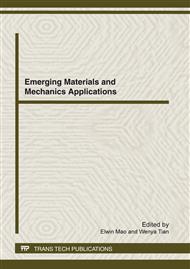p.445
p.449
p.453
p.457
p.462
p.466
p.471
p.476
p.481
Preparation of Porous Ti Plate with Nanograde Pore Size by Dip-Coating Method
Abstract:
The porous Ti plates with nanograde pore size were successfully prepared by dip-coating technique, using stainless steel plates as support and 400mesh Ti powders as raw material. The stainless steel plates were firstly dipped into Ti slurry and then pulled out with desired withdrawal velocity. After sintered in a vacuum furnace, stainless steel supports were removed by aqua regia. The obtained products were characterized by X-ray diffraction, sanning electron microscope and N2 adsorption–desorption isotherms. The results had shown that the thickness and pore characters of porous Ti plates could be controlled by adjusting the withdrawal velocity. When the withdrawal velocity was controlled between 0.2mm/s and 1mm/s, the porous Ti plates had smooth surface without cracks and the most pores were interconnected. The maximum pore diameters could be less than 300nm and the porosities of porous Ti plates are more than 4.9%. The kind of preparation method has advantages of simple technology, easy operation and high purity. These indicated that the porous sintering Ti plates were promising to be used as ultrafilter membranes.
Info:
Periodical:
Pages:
462-465
Citation:
Online since:
March 2012
Authors:
Keywords:
Price:
Сopyright:
© 2012 Trans Tech Publications Ltd. All Rights Reserved
Share:
Citation:


